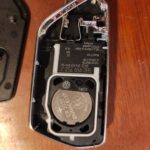The ignition coil is a crucial component in your car’s engine, and understanding Car Coil Voltage is key to grasping how your vehicle starts and runs efficiently. At its core, a car coil operates as a step-up transformer, a clever device that takes a lower voltage and dramatically increases it. This transformation is essential for creating the spark needed to ignite the air-fuel mixture in your engine’s cylinders. This process relies on two sets of wires, the primary and secondary windings, meticulously coiled around a shared iron core, all encased within a protective insulated housing.
The magic of voltage transformation happens because of the difference in the number of windings between the primary and secondary wires. The secondary wire boasts thousands more windings than its primary counterpart. Think of these windings as pathways for electricity; more pathways mean a higher capacity to handle voltage. The iron core acts as a conduit, efficiently channeling electrical energy from the primary to the secondary wire. Initially, the primary wire receives a low voltage current from the car battery, generating a magnetic field around it. However, the crucial moment occurs when this current flow is abruptly interrupted. In older distributor-based systems, this interruption was handled mechanically by the distributor. In modern electronic ignition systems, the Engine Control Unit (ECU) takes charge. The instant this interruption happens, the magnetic field surrounding the primary coil collapses. This rapid collapse induces a significantly higher voltage within the secondary wire. This high car coil voltage is then directed to the spark plug, creating the spark that initiates combustion.
What Causes Fluctuations in Car Coil Voltage and Lead to Failure?
The environment under the hood of a car is far from gentle, especially for sensitive electrical components like ignition coils. Positioned directly above the hot engine, coils endure a cycle of extreme temperature changes and constant vibrations. These harsh conditions, over time, can take a toll, leading to cracks in the coil’s windings and breakdown of its insulation. However, the most common culprit behind premature coil failure and voltage issues is car coil voltage overload. This overload typically stems from worn spark plugs with electrode gaps that have widened beyond the manufacturer’s specifications, or from damaged spark plug wires and cabling.
When spark plugs are worn or wires are damaged, it creates increased resistance in the ignition circuit. To overcome this resistance and still generate a spark, the ignition coil has to work harder and output a higher voltage. Over time, this consistently elevated car coil voltage output can become detrimental, pushing the coil beyond its design limits. This excessive voltage can cause internal short circuits as it forces its way through weakened insulation, ultimately leading to coil failure.
Diagnosing Car Coil Voltage Issues and Faulty Coils
Several symptoms can indicate problems with your car coil voltage and potentially a failing ignition coil. Engine misfires, characterized by jerky acceleration or a feeling of hesitation, and backfires, loud popping noises from the exhaust, are common indicators. You might also experience difficulty starting the engine, a noticeable decrease in engine performance, and a drop in fuel efficiency. In vehicles with distributor-based ignition systems, a failing coil will typically affect all spark plugs. However, in modern cars with electronic ignition systems, each spark plug (or pair of plugs) often has its own dedicated coil. Therefore, a fault might only impact one or two cylinders.
Vehicles manufactured after 1996 are usually equipped with an engine management system that monitors engine performance and can detect misfires. When a misfire is detected, the system often generates a Diagnostic Trouble Code (DTC) which can be accessed using an OBD-II (On-Board Diagnostics II) scanner connected to the OBD port. While a fault code can point towards a misfire, it’s important to remember that misfires can be triggered by various ignition and fuel delivery problems, not solely by a faulty coil or car coil voltage irregularities. Therefore, a thorough diagnosis is crucial. Begin by visually inspecting and checking the condition of the spark plugs and, if applicable, the high-tension (HT) leads. Examine the coil itself for any signs of physical damage or loose connections. For a more definitive diagnosis, use a multimeter to measure the primary and secondary resistance of the coil and compare these readings against the manufacturer’s specifications. Deviations from the specified resistance values can confirm a faulty coil.
Car Coil Voltage and Repair Options: Replacement is Key
Unfortunately, repairing a faulty ignition coil is generally not a viable option. Due to the intricate internal construction of a coil and the precise nature of its operation, replacement is almost always the only practical solution. While replacing a coil is typically a straightforward process, especially in modern vehicles where coils are easily accessible, the cost of replacement can vary. Coil prices can range depending on the vehicle make and model, and whether you opt for original equipment manufacturer (OEM) parts or aftermarket alternatives. Ensuring the correct car coil voltage and specifications are matched to your vehicle during replacement is crucial for optimal engine performance and longevity of the ignition system.

